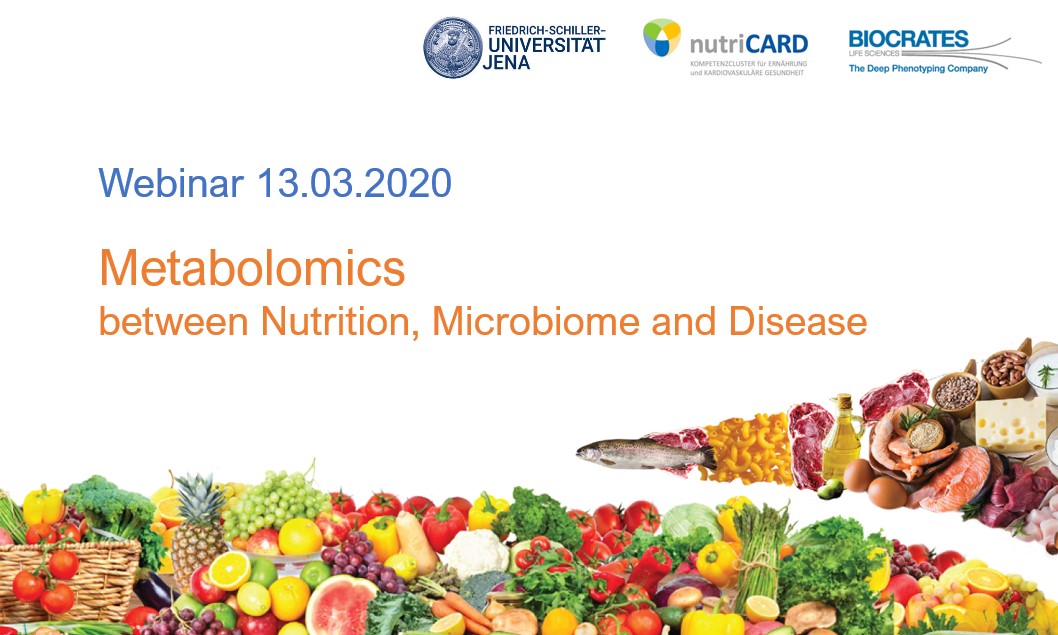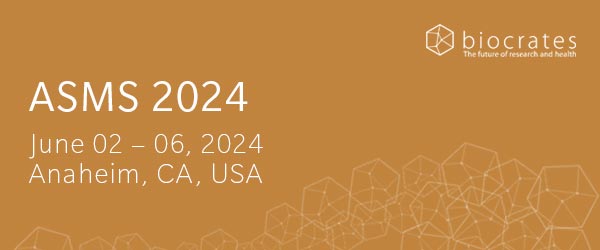Webinar recap – Metabolomics, Nutrition, Microbiome
In times of the coronavirus SARS-CoV-2 pandemic spreading all over the world, challenging our health as well as creativity, the organizers of the Metabolomics Symposium “Metabolomics – between Nutrition, Microbiome, and Disease”, which should have taken place on March 13, 2020 in Jena, Germany, decided to turn parts of it into a free online webinar (available on demand).
Metabolomics – a Powerful Tool for Microbiome Research
The webinar comprises three talks by experts from the field of metabolomics, nutrition, and microbiome research with a short introduction by Prof. Dr. Stefan Lorkowski, director of the Institute of Nutritional Science and chair of Nutritional Biochemistry and Physiology at the Friedrich Schiller University in Jena. He is also the coordinator of nutriCARD, a competence cluster for nutrition and cardiovascular health. Prof. Lorkowski emphasizes the importance of metabolomics in microbiota and nutrition research.
Strategies and Limitations in Microbiome Studies
The first talk was presented by Prof. Dr. Dirk Haller, chair of Nutrition and Immunology at the School of Life Sciences Weihenstephan (WZW) of the Technical University of Munich, director of the interdisciplinary corporate research center (ZIEL) Institute for Food & Health, and program director of the research center on Microbiome Signatures of the Department of Nutrition and Immunology at the Technical University of Munich.
Prof. Haller critically reflects on the current concepts to understand the function of the microbiome and its effect on health and disease. He highlights three main limitations in microbiome research today, which make it more difficult to compare and merge data from different studies.
- Homogenous sampling is challenging but crucial
- Available methodological tools such as 16S rRNA gene sequencing can introduce biases
- Current research oftentimes only shows correlations, not causality
One example in which a causal relationship between disease and microbiome could be shown is Crohn’s disease. Microbial transfer from patients into germ-free mice results in diseased mice.
Collectively, Prof. Haller suggests combining information on the microbiome and the metabolome by statistical methods, such as machine learning, to improve the identification and validation of disease-related signatures to be used as biomarkers for risk prediction and therapy decisions.
Script of the question and answer session Prof. Dr. Haller (pdf)
Metabolite Profiles as Fingerprints of Food Intake
Prof. Dr. Lars Ove Dragsted, head of the section Preventive and Clinical Nutrition of the Department of Nutrition, Exercise, and Sports at the University of Copenhagen, and a member of the Food Biomarkers Alliance (FoodBAll) is the second speaker.
Prof. Dragsted points out that the major problem in nutrition research is the lack of trustworthy dietary assessment tools. To avoid errors, measuring metabolites related to certain foods may provide new information that tell us, what exactly a person ate. The aim of the FoodBAll project is to define biomarkers for different food groups and specific foods, including fruit and vegetables, cereals and whole grain, meat, eggs, and dairy products, as well as beverages. Within the scope of the UNINA intervention study investigating the effects of the Mediterranean diet and its influence on the microbiome, metabolites in human serum, urine, and fecal samples were measured. Overall, the Mediterranean diet resulted in decreased markers for proteolytic degradation (e.g. p-cresol sulfate, indoxyl sulfate, phenylacetylglutamine), reduced levels of tryptophan metabolites, increased urolithins levels mainly derived from nuts, and increased biomarkers for wholegrain intake. All promoting a healthy lifestyle.
Taking into consideration all those factors, Prof. Dragsted highly recommends to accurately classify, validate, and combine markers to establish robust food intake biomarkers, which can be used to identify misreporting in dietary assessments. Their application in correcting statistical analyses would be a major leap forward in nutritional science.
Script of the question and answer session Prof. Dr. Dragsted (pdf)
Methods for the Functional Analysis of Microbiome-Host Interaction
The third presentation was held by Prof. Dr. Martin von Bergen, head of the Department of Molecular Systems Biology at Helmholtz Centre for Environmental Research (UFZ) in Leipzig, and chair for Functional Proteomics of the Institute for Biochemistry at the University of Leipzig.
Prof. von Bergen again points out that we have to be cautious not to confuse statistical correlation between a microbial taxon and a certain disease with functional causality. Tools need to be applied, other than animal models displaying limitations, to prove causality. Prof. von Bergen doubts that the activity of one bacterial taxon can be predicted solely from its abundance, as most experiments proving such hypotheses are performed in single culture, which does not reflect the rich bacterial consortium present in the gut.
Prof. von Bergen shows several examples for functional readout of the microbiome via metabolomics, most notably a recent study on Roux-en-Y gastric bypass (RYGB) for the treatment of obesity and its implications for the microbiome.
Script of the question and answer session Prof. Dr. von Bergen (pdf)
All three talks demonstrate that researchers are just at the early stages of understanding the level of complexity of host-microbiome-nutrition interactions. The experts highlight the challenges and opportunities of this field in defining biomarkers to assess disease risk, diagnosis, and therapy, as well as in translating findings into a clinical setting.



